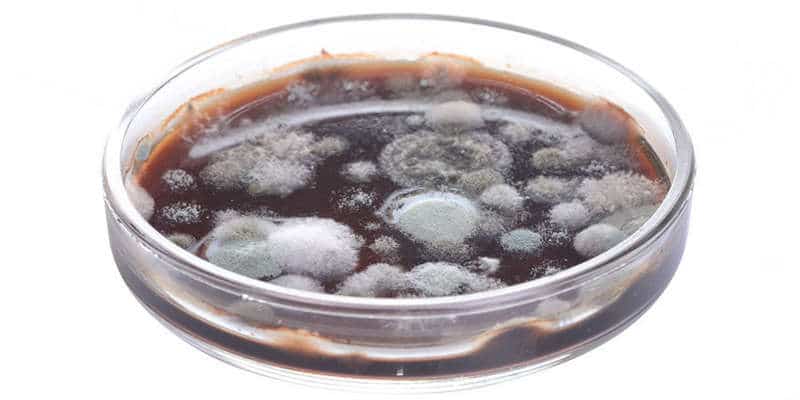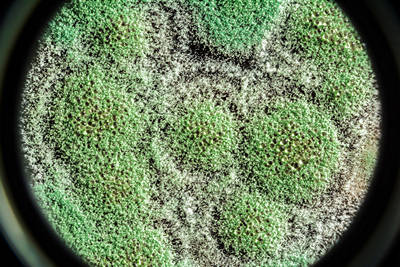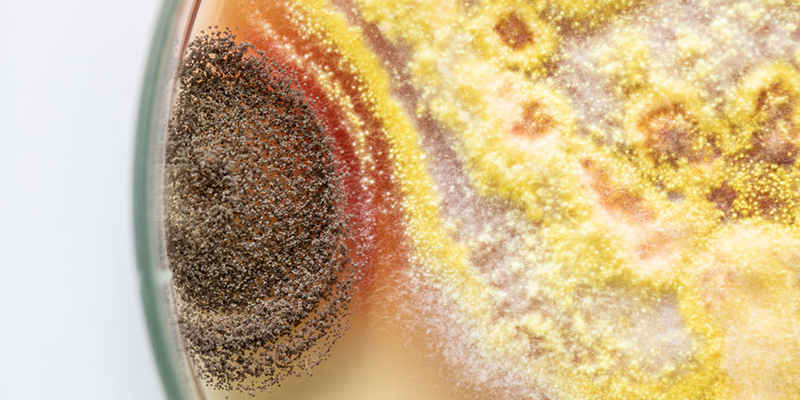Mold Test Kit - Review & Buyers Guide
With over 10,000 mold inspections under our belts, we’re passionate about finding the most accurate mold testing methods possible. The amount of choices can be downright confusing. Petri dish, tape lift, Air-o-Cell cassette? We’re here to help.
Note – in most cases, an on-site inspection by a professional is superior to using a DIY mold test kit. A test kit can only reveal whether or not you have elevated levels of mold. It cannot determine the cause.
When is a DIY mold test kit appropriate?
- Limited access to a local professional. Trustworthy mold inspectors are difficult to find in large metro areas, let alone less populated regions.
- Lower cost initial test. A fully featured on-site inspection will undoubtedly cost more than a DIY mold test kit. A home sample kit can be a good way of determining whether you want to spring for a full fledged inspection.
- Verifying a remediation project. Perhaps you’re a bit leery of the quality of a remediation job at your home. A mold test kit (used appropriately) can help verify if the mold was properly removed.
Petri dish style test kits
As the name implies, these mold test kits utilize a petri dish as the test media. The petri dish contains a substance conducive to mold growth (potato dextrose in most cases). Once the lid is removed, mold spores in the ambient air can settle on the growth plate. Typically the dish is kept open for 1 hour and the lid is replaced.
Over the next 48 hours, the mold spores are allowed to grow inside the petri dish. Depending upon a variety of factors, you may find absolutely nothing or a flourishing mold colony.
This is where it gets tricky.
Problem 1 – No quantifiable data
Let’s say the petri dish is covered with a thick layer of mold. Does this mean your home has highly elevated levels of mold spores? Well… that’s where the analysis becomes a bit fuzzy. How do you quantify the growth? Moderately moldy vs. really moldy? A lot of fuzz vs. really fuzzy? There’s no way to pull quantifiable data from the growth.
Several of the companies offering petri dish style mold test kits do provide a follow up lab test. The lab will send you a report detailing the type of mold found growing on your sample. The results, while interesting, provide little actionable data. The type of mold is of very little consequence. What matters is whether it’s growing in your home. Every home has mold spores (they float in through the doors, windows and on your clothes).
For example, let’s say your lab results show Stachybotrys was growing on your test kit. Did this mold originate within your home or float in the front door? It only takes a single spore to propagate mold growth, and there’s simply no way to determine whether the mold came from an indoor source.
Compare this to the gold standard test – a non-viable cassette. Because these mold test are collected with a specific quantity of air, you can examine the quantity of spores. With this information, it is much easier to determine whether a home is suffering from an internal mold problem.

Mold test kit with moderate growth.
Problem 2 – They’re highly dependent upon the mold’s growth rate
Molds grow at wildly different rates. Some can flourish in dry, seemingly inhospitable conditions, while others require completely saturated materials. How a mold spore grows on a petri dish is not a reliable indication of how it will grow in your home.

Heavy mold on test kit
For example, let’s say you check your mold test kit after 48 hours and find the dish overflowing with growth. Looking at the dish, you would reasonably conclude your home has a high level of mold. In reality, your home may have a very low level of mold. The few spores that are present just happen to be the fast growing type. Assuming you don’t have an active water leak or excess humidity, there’s nothing to worry about.
This problem is exacerbated by another important consideration. Different molds prefer different growth substances. Yet a petri dish only contains a single type of growth media. For example, Stachybotrys needs a cellulose or corn meal agar to properly grow. Your house could have highly elevated levels of Stachybotrys mold spores and yet show very little growth on the potato starch agar found in most DIY mold test kits.
Caveat. Petri dishes can be an effective form of testing, if combined with a powered vacuum pump and an Andersen Plate. This system injects a calibrated quantity of air onto the surface of the petri dish. Because the airflow is regulated, the results can be compared to other samples. Note – this is not an option for a home mold test kit, as the required equipment is expensive.
Problem 3. Mold growth is based on competition on the petri dish, rather than representing the air in the home.
Notice in the photo below how the two (or more) types of mold growth are competing for space. This is yet another factor where the mold growth observed on the test kit dish is not representative of the mold in your air. Molds vary widely in their ability to compete with one another. While interesting in a lab setting, this is of little importance in your home. The fact one species is beating out another in the dish does not correlate to real world conditions.

Molds competing for space on a petri dish.
Problem 4. Unstable test kit media (gel within the petri dish)
The purpose of a petri dish is to provide a consistent growth platform for the organism in question (mold in this case). To maintain this consistency, the growth substance within the dish must be kept in a controlled environment. If the substance dries out, the mold will grow at an artificially slow pace. In the professional mold testing world, these petri dishes are shipped overnight and must be kept refrigerated before and after usage in the field. A mold test kit sitting on the shelf on your local hardware store is certainly not kept in these conditions.
Pros
- Fun science experiment
- Cheap
Cons
- Limited correlation with actual indoor air quality
- Easily affected by cross contamination
- Can’t compare results with other samples
Tape Lift Style Sample Kits
These sampling kits get their name from the lifting of spores from a surface. A bit like lifting a fingerprint, a tape lift kit utilizes a sticky tape like material to pull spores from a surface. The tape is applied to a plastic or glass slide and sent to the lab. The lab examines the slide under a microscope, looking for mold spores. Typically, the lab reports the type of mold and a rough evaluation of the quantity (i.e. a scale of 1-5).
The tape lift kits available online are quite similar to those used by professional mold inspectors. Let’s look at some of the limitations.
Limited ability to measure human exposure
The greatest shortcoming of these kits is their inability to evaluate the amount of mold in your home’s air. From a health standpoint, this is a major detraction. Why? Because mold growing on a surface (i.e. wall, ceiling, clothing) does not necessarily correlate to the amount of mold spores in the air. You might have a wall covered in mold growth and yet very low quantities of mold in the air. Molds release their spores during specific phases of their growth cycle. The age, available water, temperature, etc. all play a role in the release of spores.
Homes can also have the opposite circumstance. A basement with a damp carpet will often have no visible growth. And yet the room may have hundreds of thousands of spores per cubic meter. A tape lift sample cannot accurately assess either of these situations.
It verifies the obvious (in most cases)
Most of the time, mold growth is fairly obvious. If it looks like mold, it’s usually mold. There are a few substances that can masquerade as mold growth – efflorescence can have an uncanny resemblance. In these cases, a tape lift sample is an inexpensive way to determine whether or not you’re looking at fungal growth.
Tape lift samples can also determine the type of mold. The laboratory will provide a report identifying the type (typically genus, not species) of the mold growth.
Pros
- Accurate assessment of mold type (genus level)
- Fast lab analysis
- Inexpensive
Cons
- Doesn’t measure human exposure (the mold spores you’re breathing)
- Can’t determine the severity of the growth.
Best Usage
Tape lift sample kits are ideal for verifying whether a suspicious visible substance is mold.
Air Pump Sample Kit
While swab and bulk samples can be helpful, air sampling is far more useful in most situations. This is due to air sampling’s ability to text for the exposure to mold. A tape lift sample simply tells you whether a particular substance is mold. This has little bearing on whether the mold has impacted the indoor air quality. It’s fairly common to find homes with substantial visible mold growth and very little airborne spores. The opposite is often found as well. Often the jobs with the highest spore counts are those with elevated humidity, poor air flow and wall to wall carpeting. There’s no visible mold in the carpet, but the quantity in the air is very high. This is where air pump sample kits shine. They will determine the most important factor – the impact on the indoor air quality.
Air pump sample kits come in two styles: viable and non-viable. Viable sampling is only useful in a very narrow range of circumstances, usually involving a court case or research. The vast majority of samples are collected via the non-viable technique. This simply means we’re not concerned with identifying whether the mold is active or not. We’re focusing on the type and quantity of the spores.
Examples
- Air-O-Cell / BioPump
Pros
- Measures actual health exposure (quantity of spores in the air)
- Industry standard – can be compared to other test results
- Fast turn around time
Cons
- Can be expensive
- Can only identify the genus, not species
*Heads up – I earn a small commission on sales through Amazon links. This helps cover the expense of running the website (and answering your questions!)
